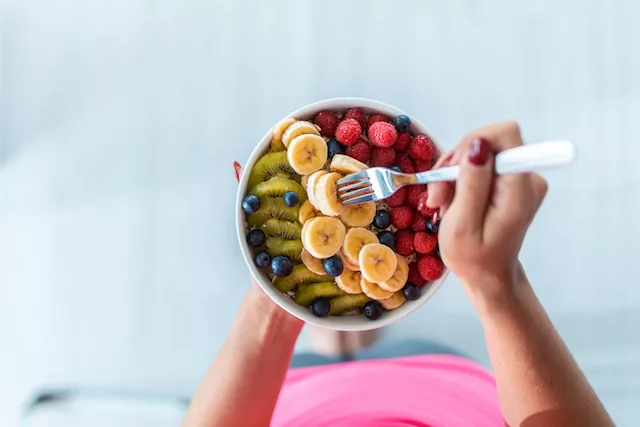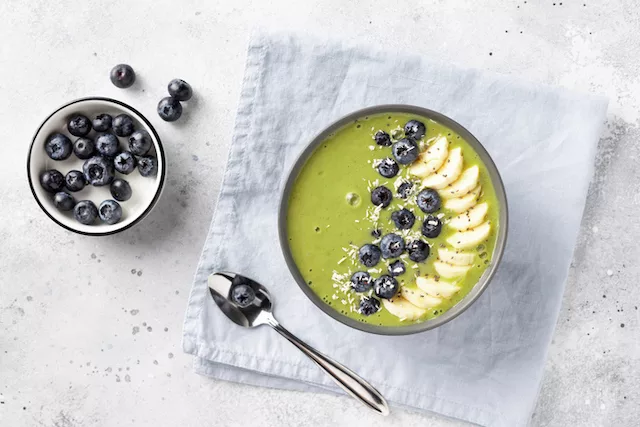It always seems like one recipe style takes over TikTok—you start seeing it pop up all over your feed, but featured in all sorts of different ways. That’s what’s going on right now with smoothie bowls, which have exploded in popularity in recent years. This once-niche health food has now become a mainstream staple in people’s diet.
These thick and creamy concoctions are far more than just visually appealing; they’re also loaded with nutrient-rich fruits, veggies and grains that boost your health in a myriad of ways. “Smoothie bowls can be an easy way to include vitamins, minerals, and antioxidants, which can support overall health, including heart health by providing nutrients like potassium and fiber that help manage blood pressure,” says Michelle Routhenstein, R.D.N., Registered Dietitian Nutritionist and Preventive Cardiology Dietitian at EntirelyNourished.com.
It’s worth pointing out that smoothie bowls are a bit different than regular smoothies—while they do share a common base of blended fruits and veggies, they differ primarily in their texture and presentation.
For example, regular smoothies tend to be thinner and more liquidy. You also tend to drink smoothies through a straw. Smoothie bowls on the other hand, are thicker, creamier and served in a bowl, which allows for toppings and generally makes for a more well-rounded and filling meal.
Check out these tasty and health-conscious smoothie bowl recipes that are designed to cut-back on bloating while powering you with energy.
Smoothie Bowls and Bloating: Fact or Fad?
To understand the potential for smoothie bowls to truly banish bloating, it’s important to examine their core components. Firstly, many smoothie bowls feature a base of frozen fruit, such as berries, bananas or mangoes blended with a liquid like coconut water, almond milk or Greek yogurt. Since they’re laid out in a bowl, it’s quite common to incorporate toppings, such as granola, seeds, nuts and even fresh cut-up fruit.
While these ingredients can be undeniably nutritious, boosting vitamins, minerals, and antioxidants, their role in bloating is complex. For starters, it depends on the actual ingredients of a given smoothie bowl to ascertain whether or not it can truly cause or prevent bloating.
On the upside, many smoothie bowls are jam-packed with fiber, since they feature a lot of fruits and veggies. This fiber can help aid digestion and prevent constipation, both of which are a common contributor to bloating, Routhenstein explains. Moreover, some smoothie bowls incorporate ingredients like chia seeds or flaxseed, which contain soluble fiber that can absorb water in the digestive tract, potentially easing discomfort.

Since smoothies are mostly liquid, they also tend to be hydrating, but can help encourage optimal digestive function.
While smoothie bowls tend to be more healthy than harmful overall, it is worth noting that some, especially those that you purchase at a store or a smoothie bar, can be high in added sugars. This can unfortunately lead to digestive issues, according to research.
It’s also worth pointing out that certain fruits and sweeteners that are commonly used in smoothie bowls might contain what’s known as FODMAPs (fermentable oligosaccharides, disaccharides, monosaccharides, and polyols), which can cause bloating in sensitive individuals. If you do happen to be sensitive to these certain foods high in FODMAPs, such as oats, quinoa, apples, apricots, grapes, mangoes, peaches, plums, etc., you may very well experience bloating from a smoothie bowl.
Dairy products, like Greek yogurt, are another potential culprit, as lactose intolerance affects a significant portion of the population. Gluten-containing ingredients, such as granola with added wheat, can also trigger bloating in individuals with gluten sensitivity or celiac disease.
Last, but not least, another drawback to smoothie bowls is that they lack the solid texture of regular meals. If you’re replacing a meal with a smoothie bowl, it’s possible that it could impact your satiety and hunger, according to a study published in the journal Nutrients.
The Best Smoothie Bowl Recipes to Banish Bloat
It is possible to create a smoothie bowl that does help cut down on bloat—instead of causing it. First, you want to make sure you’re choosing the right base ingredients—ideally low-FODMAP fruits (berries, bananas, pineapple or melon) if you tend to be sensitive to them, unsweetened liquid like almond milk or coconut water if you’re using something other than regular water and the addition of probiotics such as Greek yogurt of kefir to help support gut health.
Here are some of the best smoothie bowl recipes for cutting back on bloat and cashing in on health and wellness.
Green Goddess Smoothie Bowl
This smoothie bowl is a powerhouse of hydrating and anti-inflammatory ingredients. Cucumber and pineapple work together to ease digestive discomfort and reduce bloating, while spinach adds a rich source of essential vitamins and minerals. Additionally, the bowl includes chia seeds for added fiber and omega-3 fatty acids, and a splash of coconut water for extra hydration, notes Routhenstein. Topped with fresh berries and a drizzle of honey, this smoothie bowl is not only nutritious but also delicious, making it a perfect start to your day.
Base: Spinach, cucumber, avocado, pineapple, coconut water
Toppings: Chia seeds, hemp seeds, sliced almonds, a drizzle of honey

Berry Blast Smoothie Bowl
Chock full of antioxidants and fiber, both of which aid in digestion and overall gut health, this smoothie bowl lives up to its name. Incorporating Greek yogurt into your smoothie bowl adds probiotics, which further support a healthy digestive system and enhance gut flora. For an added crunch, top your bowl with granola, but choose one that’s low in added sugars to prevent bloating. The combination of these ingredients supports digestive health while also providing a delicious and satisfying meal that can keep you energized throughout the day.
Base: Mixed berries, banana, Greek yogurt, coconut water
Toppings: Granola (check for low-sugar options), sliced strawberries, a sprinkle of bee pollen
Tropical Paradise Smoothie Bowl
Want to feel like you’re on a tropical vacation without having to book a flight? Try this smoothie bowl featuring mango and papaya, both of which are celebrated for their potential to ease digestion. Mango contains amylase enzymes which help the body break down carbohydrates. These enzymes, similar to those found in our saliva, initiate the digestive process, making it easier for our bodies to absorb nutrients, explains Routhenstein.
Papaya also contains an enzyme called papain, which is best known for its protein-digesting abilities. This enzyme can help break down complex proteins into smaller, more manageable peptides, reducing digestive strain. To top it all off, papaya is rich in fiber, which also contributes to overall gut health and regularity.
When combined in a smoothie bowl, these tropical fruits create a dynamic duo that can support a healthy digestive system.
Base: Mango, papaya, coconut milk, pineapple
Toppings: Coconut flakes, sliced almonds, a squeeze of lime
Creamy Cucumber and Mint Smoothie Bowl
Cucumber has a high water content, so it’s long-been associated with relief from digestive discomfort, notes Rothenstein. One study, published in the journal Nutrients, even found that cucumber, along with a few other veggies like spinach and carrot, were linked to a reduced risk of gastric disease.
Mint has been used for centuries to reduce unpleasant stomach symptoms like bloating. Its compounds can help relax the muscles of the digestive tract, reducing spasms and bloating. If you happen to be feeling nauseous, mint can also help provide some temporary relief.
Base: Cucumber, spinach, mint, coconut water, Greek yogurt
Toppings: Sliced avocado, hemp seeds, a sprinkle of red pepper flakes
What to Know Before Making Your Own Smoothie Bowls
Before you get in the kitchen and start whipping up your own smoothie bowls with the goal of reducing bloat, be sure to check the ingredient list of any store-bought granola or yogurt to ensure they align with your dietary needs. The last thing you need is a dairy base when you’re lactose intolerant.
It’s also helpful to adjust the sweetness to your preference using natural sweeteners like stevia or monk fruit instead of actual sugar cane. Not only are they naturally calorie-free, but they have a lower glycemic index, which means they have minimal impact on blood sugar levels, making them a better option for individuals with diabetes or insulin resistance.
The Takeaway
Over time and after a little experimentation with different ingredients, you will find the right smoothie bowl recipes that work best for your body, so you can reap the benefits of a delicious meal and manage symptoms of bloat.
